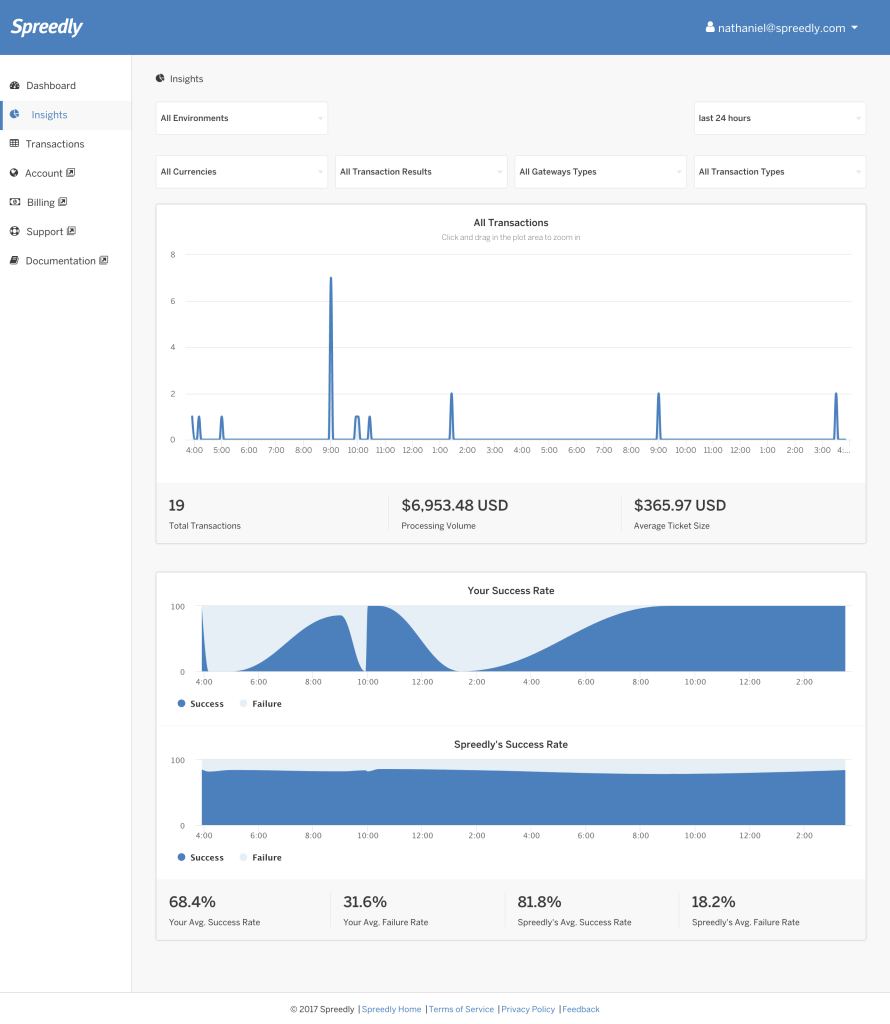Offering one API that connects to multiple gateways or third-party services, Spreedly provides options for businesses that want to minimize time spent adding and managing APIs.
In this Spreedly review, we’ll look at how it works, costs, and if it makes sense for small businesses.
What is an API? What is a gateway?
In the broadest sense, a gateway enables credit and debit card transactions. When talking about ecommerce payments, you can think of the gateway as the credit card machine of the internet.
You’ll connect your machines or services to a gateway through an API, or application programming interface. Each gateway has their own API, meaning that if you want to change gateways or utilize more than one gateway, you would also need to change (or add) an API.
About Spreedly
Spreedly aims to simplify APIs. Rather than requiring you to connect gateways and services individually through multiple APIs, you’ll instead connect through the Spreedly API.
This company offers this introduction video explaining how it works:
Card Storage Vault
One of the features the company pushes the most is its secure card storage vault. Most processors offer card storage vault options, but Spreedly points out that you may not be able to take your stored data with you if you switch processors.
With processor-based card vault options, businesses that want to accept credit cards on a recurring basis (such as subscriptions for goods or services) work with the processor to set up a vault in order to charge the customer’s card at set intervals.
Spreedly’s card vault works much the same way, except that it’s not tied to one specific processor. Rather, your vault is set up with Spreedly, meaning that even if you switch processors, you won’t lose your stored card information.
Businesses That Could Benefit from Spreedly
CardFellow spoke with Spreedly to see which businesses would benefit the most from this type of universal API.
While the company mentions that their service works for anyone, those likely to see the most benefits are businesses that expand into international sales, businesses that function as platforms connecting to multiple other sellers, and businesses that connect to other third-party API’s, such as fraud services.
International Sales
In the case of international credit card processing, Spreedly points out that when some businesses go to expand internationally, they find that their current gateway doesn’t cover the region(s) to which they’re expanding. In that case, they would need to either change gateways or add another gateway. Utilizing a single API makes it easier to connect the right combination of services.
Platforms Connecting to Sellers
Businesses that operate as a platform connecting to other sellers (such as third-party food delivery services) need the ability to support payments to multiple sellers, all using different gateways. Spreedly enables easy connection to those sellers for seamless payment acceptance.
Related Third-Party Services
Some third party services, such as advanced fraud protection or chargeback management systems, may require you to connect through an API that isn’t part of your gateway. With Spreedly, you’d be able to do so simply, through the Spreedly API.
Businesses That Want a Failsafe
Sometimes, gateways go down. If your primary gateway is unusable for some reason, Spreedly can direct transactions to your secondary gateway choice. That can help you keep business running smoothly and avoid customer payment interruptions while you troubleshoot issues with the primary gateway.
You would need to have an account set up with the secondary gateway already, as well as the connection via Spreedly. But once you do that, you’ll have the ability to redirect payments to that secondary gateway if needed.
In all of these situations, you’ll be able to connect once and then easily maintain your connections. Adding new connections is simplified compared to the process of managing connections via multiple APIs. You’re not required to have multiple gateways if you use Spreedly, but it’s an option available to you.
Spreedly Dashboard
In 2018, Spreedly rolled out an updated dashboard based on customer feedback. The new dashboard allows you to monitor transactions directly from Spreedly to see success rates, transaction volume, and more. You can even compare success rates between your different gateways to ensure you’re using the gateway with the highest success rate.

The new dashboard also includes easier troubleshooting, allowing you to search for failed transactions and error messages.
How much does Spreedly cost?
Previously, Spreedly published pricing on its website. Pricing is not readily available at this time. In the past, Spreedly offers 3 plans, called “Starting,” “Growing,” and “Scaling.” The smallest plan allows two endpoint connections, the middle plan allows 10, and the largest plan allows unlimited connection.
When previously published, pricing was as follows:
- The Starting plan will cost you $200 per month plus 5 cents per API call.
- The Growing plan will cost you $500 per month plus 2 cents per API call.
- The Scaling plan will cost you $1,500 per month plus 0.5 cents per API call.
These costs may have changed, and Spreedly no longer prominently displays plan pricing.
Theses costs are separate from the costs you’ll pay to take credit cards. You’ll still pay your processor in order to accept cards.
Is Spreedly worth the cost?
Using Spreedly definitely drives up your monthly costs, so it can be cost-prohibitive for some businesses. If you’re using a gateway for basic retail functions and don’t have specialty needs like international payments or a marketplace-style platform, Spreedly isn’t really worthwhile.
The solution is primarily beneficial to businesses that would otherwise manage many different APIs. If that’s your business, Spreedly can help you minimize your time spent on API connections and may be a good fit.
Have you used Spreedly? Would you recommend it to other businesses? Let us know in the comments!



